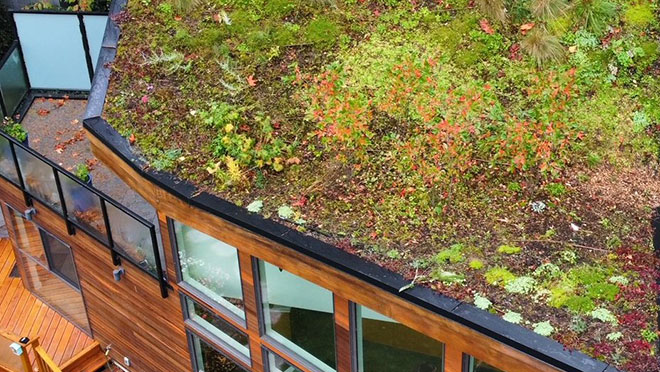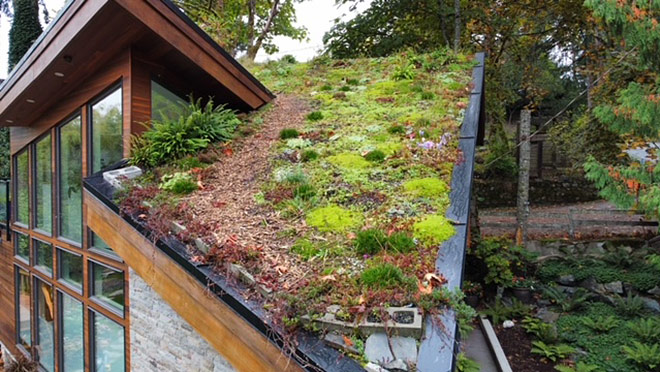Shade trees, food gardens, and a mayor's green roof

B.C. warming to the idea of eco-friendly approaches to gardening
The double-whammy of a heat dome and a record-breaking December cold snap saw home energy bills in B.C. spike in 2021, but some homeowners fared better than others.
"I have to say, we didn't even notice the heat," says Fred Haynes, who is almost as well known for the green roof on his home as he is for being the mayor of Saanich. "We probably only had to use our heat pump for cooling for about four days last year. And our heating costs are markedly lower than any other house on the street."
If you fly over Saanich's Prospect Lake, you'll see a lot of trees surrounding waterfront homes, but you'll have a tough time spotting Haynes' house. From above, all you see is a garden that's home to bees, butterflies and over 100 varieties of plants.
The Haynes home is an extreme example of how British Columbians are finding new ways to use trees and plants to make their homes more comfortable and beautiful while also lowering their energy bills. Shade trees alone, when strategically placed on the south or west sides of homes, can reduce cooling costs by as much as 35%.
As homeowners' appetite for more eco-friendly landscaping grows, so do the number of gardening shops and services who offer expert advice on everything from shade trees to grass lawn alternatives. And local governments are also keen to get in the act, including the City of Vernon, which offers $25 toward the purchase of a shade tree as part of its Tree Voucher program, and the City of Kamloops, which offers $25 or $50 vouchers, depending on the price of the tree selected. The City of West Kelowna sold over 400 shade trees this spring – with four varieties to choose from – via its Urban Re-Leaf program.
Meanwhile, in Quesnel, Terra Cura Organic Gardening touts "edible landscape design" as a way of helping locals grow "as many of the healthiest, tastiest, most pest and disease resistant plants possible." Head way east to the Rockies and you'll discover Fernie's Wildsight, whose community sustainability projects include an EcoGarden learning centre and a ToolShare program that provides access to food processing tools such as apple presses and dehydration.
And to celebrate B.C.'s green gardening revolution, Team Power Smart is giving away five $100 The Home Depot gift cards you can use at their garden centre, in this month's member contest. Log in now to enter to win, or join Team Power Smart if you're not already a member.
Before we go on, a vital piece of advice: Click or call BC 1 Call before you dig. BC 1 Call recommends calling before digging for backyard projects big and small, including tree planting, fence posts, building decks, retaining walls and firepits, and anchoring playground equipment.
Learn more about the Saanich mayor's living green roof.
Seek local advice to get the right shade tree for the right place
The idea of "right tree, right place" doesn't just apply for planting trees and bushes near powerlines. It's essential to getting the right shade tree for your area, as factors including drought, insect, and disease tolerance.
Generally, if you're in a detached home, consider bushes or trees on the south and/or west side of your home where there are big windows. A deciduous shade tree blocks sunlight from hammering your home in summer, but in the fall, drops its leaves to provide the sunlight you want in the cooler months.
For a gardener's-eye view of shade trees, considerations, and varieties, check out the Vancouver Sun story written by B.C. celebrity gardener Brian Minter about shade trees. In it, he connects with a tree farmer from Oregon, serving up a lot of ideas for lesser-known varieties of shade trees, including smaller and medium-sized options such as the flowering Chinese Tree Lilac.
Ultimately, it's best to talk to a local gardener or landscaper for advice, or to the "coolest" neighbour on your street, the friend whose shade trees made their home the go-to spot during the 2021 heat dome.
For perspective on shade trees in the warmer, drier Okanagan, we talked to Travis Nagy, operations manager for Vernon's Nicholas Alexander Home & Garden. The garden centre is one of two that works with the city's Tree Voucher Program to help improve Vernon's tree canopy.
"The big thing here in Vernon is to incorporate water-wise plants that are suited to our region and are drought tolerant," says Nagy, mentioning that water restrictions are a regular occurrence in Vernon. "Trees that provide shade could range from a small lilac tree to a large maple or oak. It depends on what you're looking at, in terms of the size of your yard and the amount of sun exposure."
Here are a few tips from Nagy for planting in the Okanagan:
- Look for trees that appear natively around the Okanagan, such as poplars, ashes and oaks.
- Consider paying more for a larger tree with a mature tree ball that will provide more shade while also standing a better chance at survival.
- If you're in a newly built neighbourhood, look for native trees that may have existed their before construction.
- With the growth of wildfires in B.C., be FireSmart. Use the FireSmart BC Landscaping Hub for guidance on safely planting in your yard. Know your plant hardiness zones, and don't plant more flammable trees such as cedars and junipers near your home.
- Shade your house, but not so close that you need to prune away limbs and branches that grow too close to your home and cause a fire hazard.
Save water as you care for plants, trees, and lawns
B.C.'s cool and rainy spring may make it seem unlikely that water shortages are on the way, but you can count on that happening. Opt for drought-resistant plants where you can, and learn how not to waste water in the name of keeping our plants and lawns alive.
Water vegetable gardens slowly, in the morning, by hand, near the roots. Break up hardened dirt to allow water to soak in. If your world-class garden requires lots of water, lean on a rain barrel to supplement what you get out of the tap. Municipalities and cities, including Coquitlam and Delta offer rain barrels for residents, but you can get them at various retailers including The Home Depot.
There are good practices, and eco-friendly options, around lawns. One tip is to plant your lawn in at least a month prior to the start of water use restrictions so that rain does the watering for you. To be even more sustainable, consider adding drought-tolerant, low maintenance ground cover plants to your lawn, such as microclover and thyme.
Metro Vancouver's Growgreen Guide is a fantastic online resource for designing gardens and lawns in the Lower Mainland. Use the website's PickAPlant search tool, where search filters include plant type, sun exposure, plant height, and bloom colour.
Solar lights and other eco-friendly ideas for your garden
If you're serious about getting sustainable with your garden, there are a variety of other things you can do. And some take more of a commitment than others.
Here are a few ideas:
- Compost: Using everyday organic matter such as uncooked food scraps (such as vegetable and fruit peelings, grass cuttings, leaves, tea and coffee to produce nutrient-rich soil is a great option. Check out the City of Vancouver's advice on backyard composting.
- Go organic: There are ways to control pests without using pesticides. Start with good-quality, manure-enriched soil and use mulch to prevent disease and retain moisture. Select disease-resistant plants and help prevent build-up of disease microorganisms by rotating plants in a given area. If you need a pesticide, choose an organic one. And invite the birds to help control insects, by attracting them with birdhouses and feeders.
- Attract bees: Grow native plant species – such as clover in your lawn – to attract bees. They naturally pollinate crops and can be a real boon to your urban garden.
- Use solar lights: No wires. No effect on your electricity bill. If you'd like some light around your yard, for ambience and/or for safety, you might opt for solar lights. Take the time to find good-quality lights and maintain them well. You're not being eco-friendly if you're tossing them out after a year or two, even if you take them to a recycling depot (which you should). Get advice on how to select and maintain solar lights.
Related:
